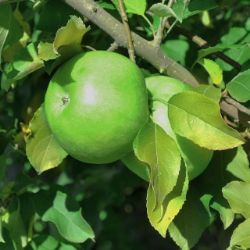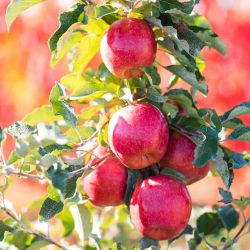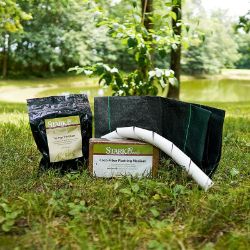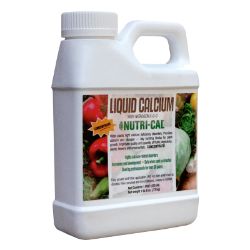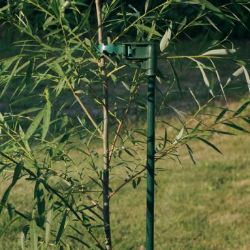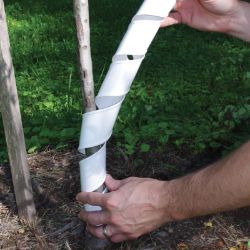Choosing a Location for Apple Trees
The best way to succeed is to plan before you plant. Let’s discuss location: Do you know where you want to plant your new apple trees? Avoid many future problems by considering all aspects of the planting spot, such as:
- Cross-pollination
- Sun and good soil
- Check out the surroundings
- Space wisely
- Leave space for future plantings
NOTE: This is part 3 in a series of 11 articles. For a complete background on how to grow apple trees, we recommend starting from the beginning.
Cross-Pollination
Is a compatible pollinator-variety present? Cross-pollination by a different variety (like Fuji, Gala, Granny Smith, etc.) of the same type of tree (apples to apples) is key to the fruiting success of an apple tree. In most cases, the lack of a compatible pollinator variety is why apple trees produce poorly, or don’t bear fruit at all. Since insects and wind need to carry pollen from blossom to blossom between trees, apple trees and their pollen partners should be planted nearby – within 100 feet of one another for adequate cross-pollination to occur.
There are a few varieties of apple trees that are self-pollinating, meaning your tree will still bear apples when it matures, without requiring another apple variety’s pollen. If you are limited on space, consider planting a self-pollinating apple tree like these:
- Golden Delicious Apple
- Stark® Jon-A-Red® Jonathan Apple
- Starkspur® Red Rome Beauty Apple
- Grimes Golden Apple
- Chehalis Apple
- Whitney Crabapple
Sun and Good Soil
Apple trees thrive when growing in a location that receives full sun and has a well-drained, fertile soil.
Full sun translates to at least six- to eight-hours of sunlight during the growing season. Light is vital to fruit production and fruit quality, and also helps keep fungal issues from advancing, so be sure to keep this in mind when choosing a location for your new apple trees.

Good soil drainage is necessary to keep an apple tree’s roots healthy, and healthy roots are the foundation of a healthy tree. If you discover that your native soil is composed of heavy clay that retains water after rainy weather, you should choose a different site for your apple tree. Similarly, if your site has fast-draining, sandy soil, then your apple tree may exhibit water-related stress (similar to conditions of drought) and may require more-frequent watering. For your growing success, we do not recommend planting apple trees in rocky or heavy, pure-clay soils. If you can’t plant elsewhere, you can try amending the soil of your planting site prior to planting your apple trees.
Amending the soil greatly depends on your individual location, so communicating with your local county cooperative extension is a wise first step. In general – to help with water distribution – you can add coir, like our Coco-Fiber Growing Medium, to your apple tree’s planting hole or mix in one-third sphagnum/peat to the soil at planting time.
Alternately, to avoid directly dealing with your native soil, you can build a bottomless raised bed (at least 12-inches deep and at least 3- to 4-feet around) in which to plant your apple tree. You can also plant apple trees in containers, starting with a pot that accommodates each apple tree’s current root system (with room to grow). Most new apple trees can be planted in a 5-gallon container to start, and you can pot-up container-grown apple trees into larger containers as the trees outgrow them.
Even if your yard isn’t the most ideal location, take heart. Apple trees can be very adaptable and they respond well to soil additives like compost or fertilizers, so they can get along well even where the soil is nutritionally poor. Just remember to avoid planting sites with extremely heavy soils and poor drainage.
Surroundings
Apple trees can also become a landscaping asset, so choose a planting site with this in mind. Imagine your new apple tree as a full-grown tree and check everything out:
- Are there wires or any other obstructions overhead?
- Are there cables, pipes, or other lines and utilities you should avoid underground?
- Is there a sidewalk or foundation within the range of your apple tree’s mature spread?
- Might your apple tree block the view of something you want to see once it’s fully grown?
- Will neighboring trees be in the way or block sunlight from your apple tree as they grow?

Even a year or two after planting, an apple tree can be very difficult to successfully transplant, so take the time to plant it in just the right place the first time around.
Space Wisely

Growers often ask about the recommended planting distances for apple trees to keep them away from patios, sewer lines, water pipes, etc. Ordinarily, patios will not be a problem because the soil beneath them is dry and compacted. The roots will not be as encouraged to grow into this area; however, it’s better to plant with at least 8 to 10 feet of space between these structures and your apple trees. A smart distance is somewhere beyond your apple tree’s estimated maximum spread. This is roughly equal to the mature height of the apple tree you choose to plant (for example: Dwarf, Semi-Dwarf, Standard. See recommendations for Space Between Trees and other structures below).
You might not expect sewer and water lines to be structures that are affected by planting apple trees, since they are buried so deeply, but, since sewer and water lines tend to be wet, apple tree roots will be attracted to them and grow around them if the tree is planted too near. By planting apple trees far enough away from these things, you can avoid problems in the near or distant future.
Space Between Trees
- Dwarf: 8 to 10 feet
- Semi-Dwarf: 12 to 15 feet
- Standard: 18 to 20 feet
- Columnar: 2 to 3 feet
Space for Future Plantings
When you’re new to planting apple trees, or you’re planting apple trees in a new location, it’s wise to start with just a few apple trees at first. Later on, especially after you have reaped the rewards of growing your own apples firsthand, you may want to expand your home orchard. It’s helpful to plan to leave room for additional apple trees, or even other fruit trees, berry plants, and other garden plants. That way, the future planting sites will be available when you are ready, without hindering your existing apple trees.















